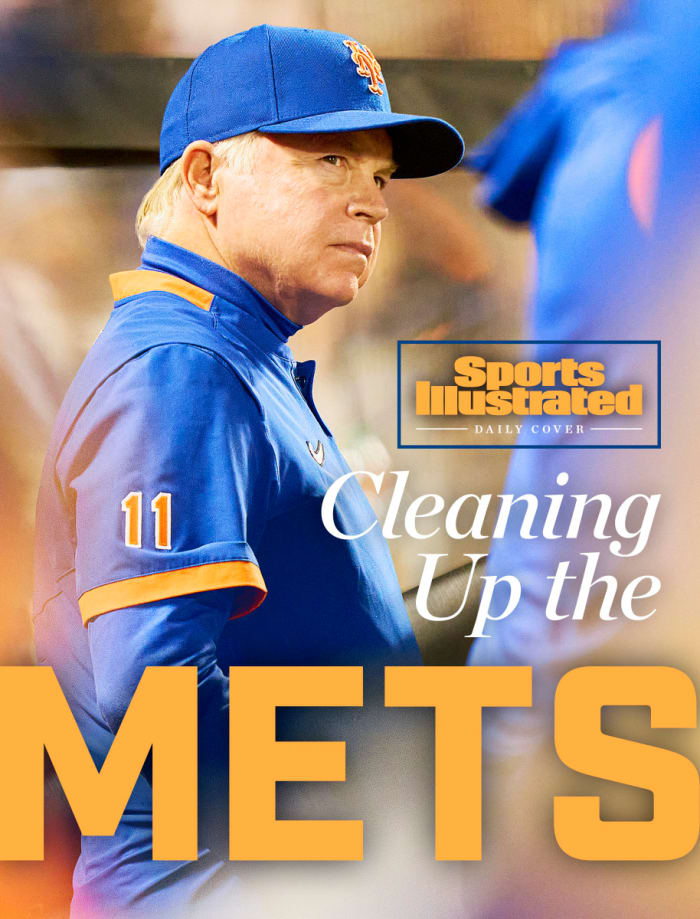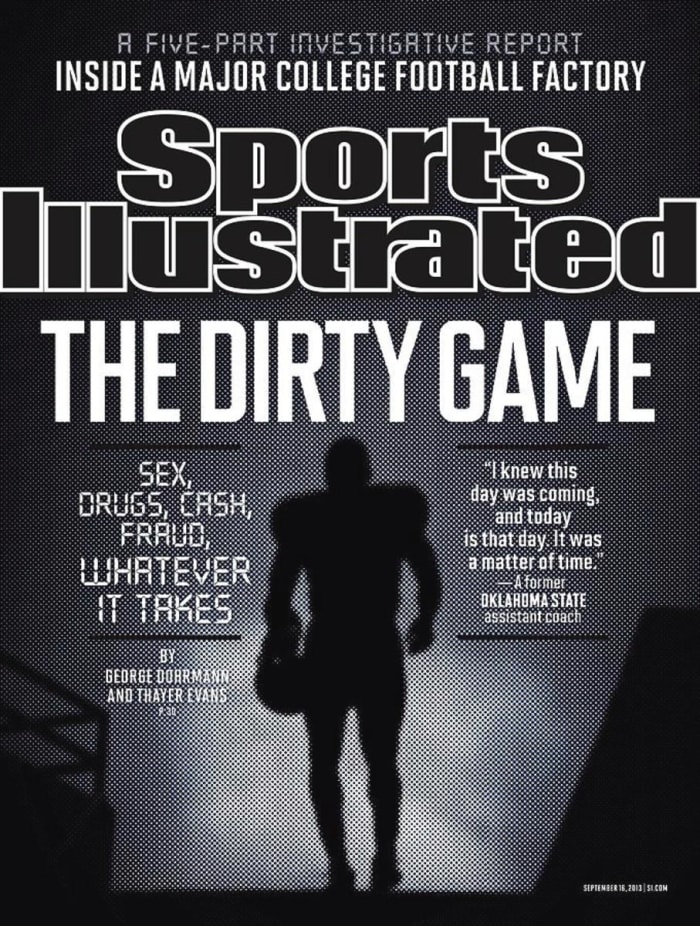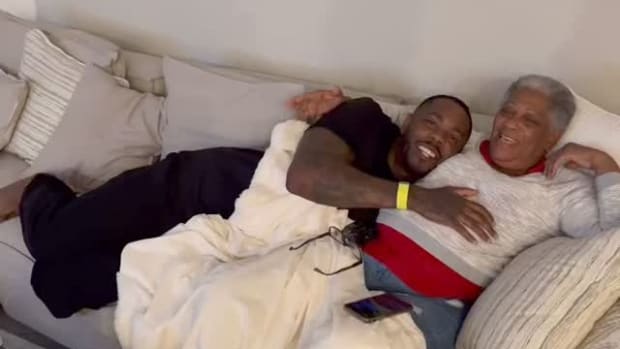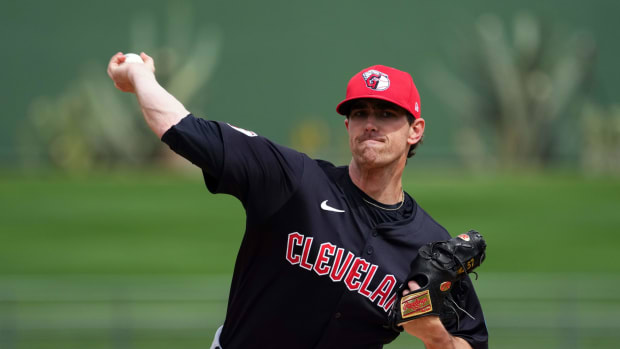
SI:AM | Can the Mets Be a ‘Normal’ Winning Team?
Good morning, I’m Kevin Sweeney. The Mets are good, and more importantly… normal?
In today’s SI:AM:
⚾ Are the Mets finally over the hump?
🙌 Mario Cristobal’s biggest test back at Miami
If you're reading this on SI.com, you can sign up to get this free newsletter in your inbox each weekday at SI.com/newsletters.
Is it finally the Mets’ time?
Mets fans have endured plenty of ugly years, finding ways to make everything seem more difficult than it needs to be. But a new regime, starting at the top under Steve Cohen’s ownership and trickling down to no-nonsense manager Buck Showalter, has brought a level of stability and competence the organization hasn’t seen in a long time. With money to spend on major acquisitions such as Max Scherzer and Francisco Lindor combined with a more steady hand running the show on a day-to-day basis, this year’s Mets barely resemble the ever-frustrating teams of the last few decades.
From Stephanie Apstein’s Daily Cover story this morning.
And indeed they are one of the best teams in the National League and are poised to make the playoffs for the first time since 2016. Most surprising of all, they have been . . . a normal baseball team. There have been no ridiculous stories sucking the oxygen out of the room for weeks at a time. Can this possibly continue? Are attitude, personnel and money—and one competent season—enough to erase decades of dysfunction? And what happens when the Mets stop being the Mets?
Where the Mets Stand in the NL East
For nearly the entire season, the Mets have maintained control of the division despite injuries to Scherzer and Jacob deGrom. But the hard-charging Braves have made life difficult lately, even briefly topping the Mets earlier this month before New York regained the No. 1 spot. As of this morning, the Mets’ lead is just one game in the division, with three games between the teams looming at the end of the month in Atlanta that could eventually decide the race.
The Mets’ roster construction with deGrom’s dominance makes holding onto the division all the more important. From Tom Verducci earlier this month:
If the Mets fall into a wild-card spot, that’s more work instead of rest for deGrom and a much tougher path for New York. If it advances it would start a division series against the Dodgers without deGrom and Max Scherzer available for Games 1 and 2. Even holding the No. 2 seed and the bye that comes with it will test deGrom because of the lockout-affected schedule. If deGrom starts Games 1 and 5 of the NLDS, he will get only one start in the NLCS, because Games 3 through 7 are scheduled for consecutive days.
It took the Braves until June 9 to get over .500 (other than a brief moment at 2–1 in early April), but they’ve been lights-out since. They’ve won nearly two-thirds of their games since the All-Star break, and, since the start of June, they’re a ridiculous 65–28. The defending champions won’t go down easily in the fight for the division and will be a factor in October regardless of whether they enter as a division champ or a wild-card team.
Other playoff races to watch: AL Central, final NL wild-card spots
The only other competitive division race at this point is in the AL Central, which has been defined by its mediocrity all season long. The Guardians, leaders by three games in the Central, would be 3.5 games out of a wild-card spot if they don’t automatically qualify for the postseason with a division win. Still, someone has to win it, and Cleveland has been a fun team to watch all season with a strong group of young players exceeding expectations and one of baseball’s most underappreciated stars in José Ramirez. The White Sox entered the year as favorites in the Central but have underperformed, toiling around .500 for the majority of the season. They have won seven of 10 though, so they’re not out of it yet.
Also worth tracking is the race for the last NL wild-card spots. The Brewers sit just 1.5 games behind the Padres and four behind the Phillies to swipe a postseason spot despite a mediocre second half. Their path to the postseason is narrow but doable, as illustrated by Tom Verducci this week.
The best of Sports Illustrated
The game of the day in college football on Saturday pits Miami against Texas A&M, and Ross Dellenger has the story on Miami coach Mario Cristobal, the son of Cuban immigrants who takes over trying to get his alma mater back to prominence.
If anything, Mario’s move from Oregon to Miami is one of family. It is one of home and heart. Few would be better suited for such a revival project than a 51-year-old coach at the top of his craft—a bilingual, Miami-bred man who grew up blocks from the university’s campus, played for the Hurricanes and began his coaching career there.
Jon Wertheim dissects the legacy of Roger Federer, who announced his plans to retire Thursday to end one of the greatest careers in tennis history. … After a program-defining win over Notre Dame, Pat Forde catches up with Marshall coach Charles Huff, whose Sabanlike approach is paying dividends. … Plus, Emma Baccellieri breaks down the legacy of Adam Wainwright and Yadier Molina’s record-setting partnership, whose longevity and loyalty won’t be matched anytime soon.
Around the sports world
The Sun aren’t done yet in the WNBA Finals, winning their fourth elimination game of the playoffs with an 105-point outburst. .. The Chiefs won yet another thriller against the Chargers, using a decisive 99-yard pick-six from rookie Jaylen Watson to move to 2–0. … Suns minority owner and vice chairman Jahm Najafi called for Robert Sarver’s resignation in the wake of his suspension for workplace misconduct. … The WNBA named its all-league teams, with Kelsey Plum and A’ja Wilson headlining the first team.
The top five...
… things I saw yesterday.
5. This unorthodox ceremonial first pitch.
4. A triple double in the WNBA Finals.
3. Appalachian State’s fans welcoming College Gameday.
2. Derwin James’s WWE-style tackle.
1. Brian Robinson Jr.’s return to practice.
SIQ
On Sept. 16, 2012, Eli Manning threw for a career-high 510 yards in a Week 2 win over the Buccaneers. Though it is the 13th best passing yards total in a game in NFL history, it is not the franchise record for the Giants. Who holds that record, with 513 passing yards in a game?
- Y.A. Tittle
- Phil Simms
- Kerry Collins
- Kurt Warner
Check Monday’s newsletter for the answer.
Yesterday’s SIQ: Yadier Molina and Adam Wainwright on Wednesday set the MLB record for most career starts as a battery with 325. Molina, unsurprisingly, is the MLB’s active leader in games played at catcher. Who is second, with more than 1,500 defensive games behind the plate?
Answer: Kurt Suzuki. The 38-year-old has struggled over the last couple of seasons with the Angels but has still been a full-time catcher, with all 102 of his starts since 2021 as a backstop.
The native of Hawai'i was drafted out of Cal State Fullerton in 2004 (where he led the Titans to the ’04 College World Series title) and came up through the A’s minor league system. Suzuki was kind of just your run-of-the-mill catcher for most of his 20s, but he made the only All-Star Game of his career as a 30-year-old in Minnesota in ’14. He found some power with Atlanta and Washington between ’17 and ’19, averaging 16 home runs per season during that stretch.
—Josh Rosenblat
From the Vault: Sept. 16, 2013
After 10 months of investigation, SI published the first part of George Dohrmann and Thayer Evans’s series detailing the corruption behind the rise of the Oklahoma State football program. From 1989 to 2001, the Cowboys had only one winning season (in 1997). Then, beginning in 2004 (Les Miles’s second season at the school), the program took off. From ’02 to ’12, Stillwater was home to one of the fastest-rising programs in the nation. Oklahoma State averaged more than eight wins per season, including six bowl game wins.
Dohrmann and Evans’s “investigation reveals the measures that a program will take to become elite—and the collateral damage that follows.”
The first part of the series was published on Sept. 13, 2013, and focuses on money. The reporters spoke with 64 former players about their time at the program, and many spoke openly about how cash flowed from boosters and, in some cases, staff members, to players.
Bonuses were delivered in a variety of ways, multiple players told SI. Sometimes players got extra money in their per diem envelopes, which were usually distributed by low-level football staff members. On other occasions an envelope with money was waiting for them in their locker the day after a game. [Thomas Wright, a defensive back from 2002 to ’04] says that if a player found a new pair of socks in his locker postgame, there was a good chance some cash was inside one of them. “It was crazy,” he says of the payouts to some of the most prominent players. “They were getting money like out of control. It was as clear as day.”
Boosters and an assistant coach also funneled money to players with “dubious work arrangements,” overpaying them for small jobs they did or just paying them for things they didn’t do at all.
Reading this investigation now is particularly interesting, especially considering how college athletes are now able to profit off of their own name, image and likeness. Boosters are still holding a prominent role in many programs, setting up NIL collectives that “are pushing the sport toward a more professionalized model, blurring the lines between endorsement contracts and employment deals,” Ross Dellenger reports. The biggest thing that’s changed in the last decade? Those payments don’t have to be stuffed inside of a sock anymore.
—Josh Rosenblat
—Josh Rosenblat
Check out more of SI’s archives and historic images at vault.si.com.
Sports Illustrated may receive compensation for some links to products and services on this website.






































